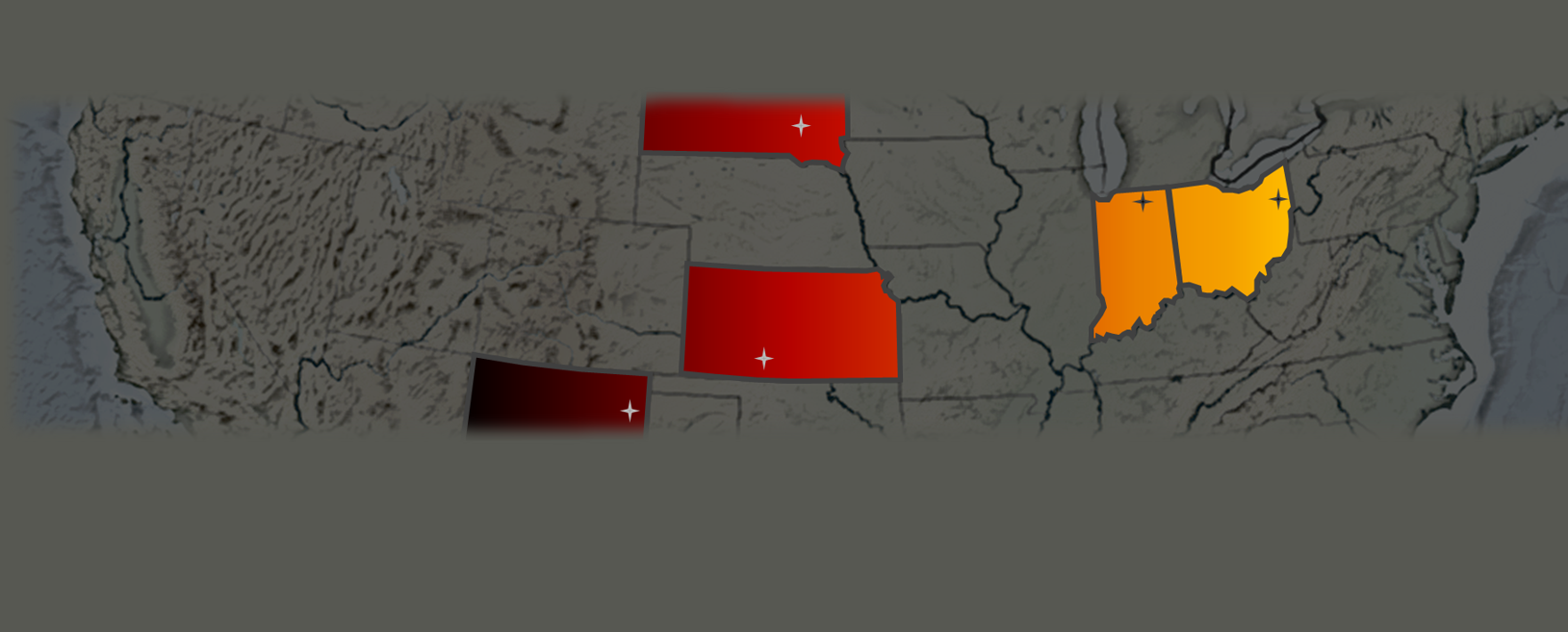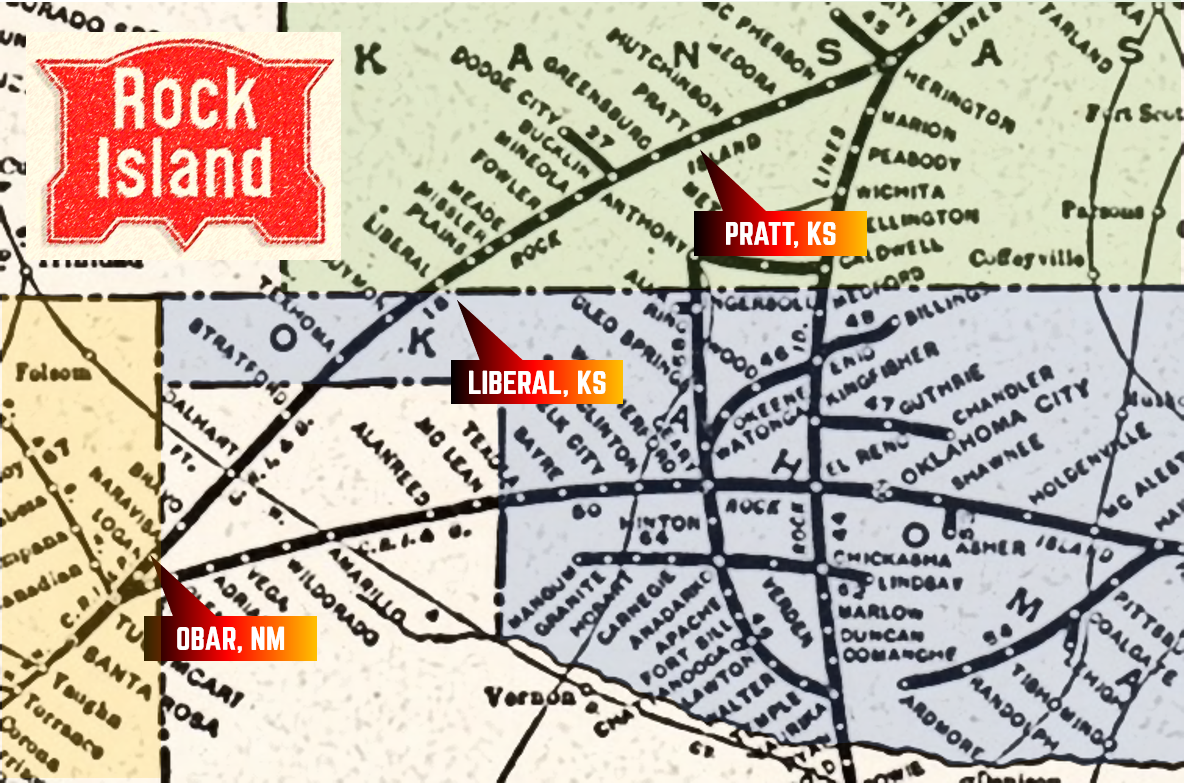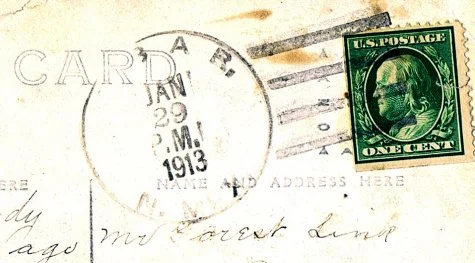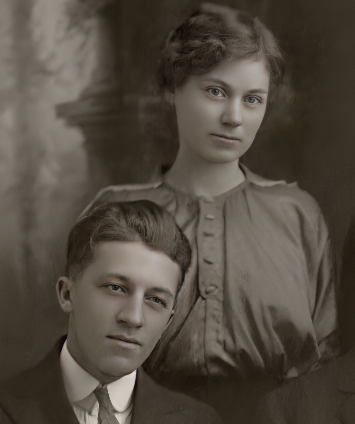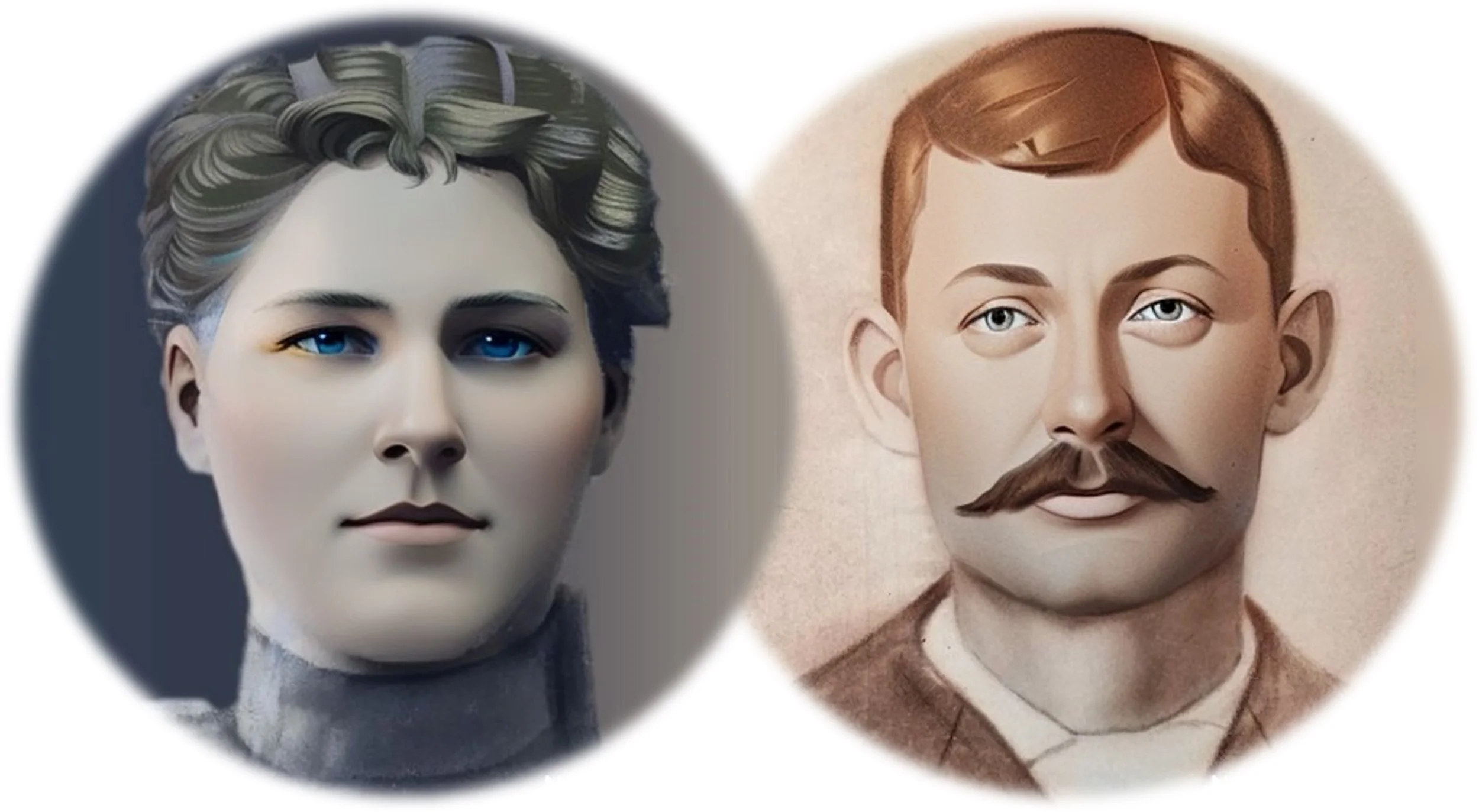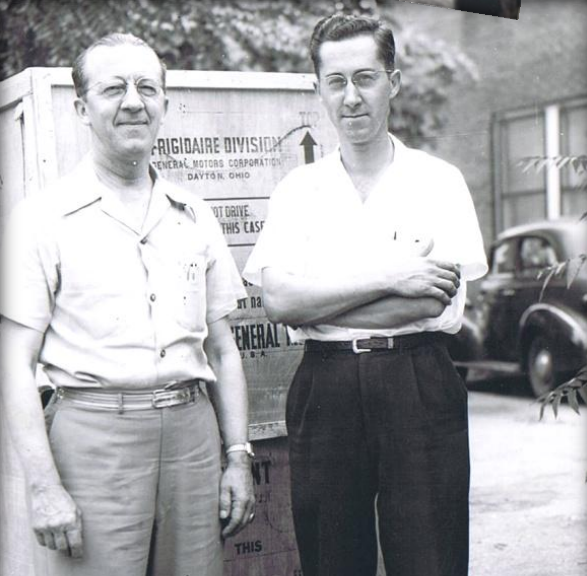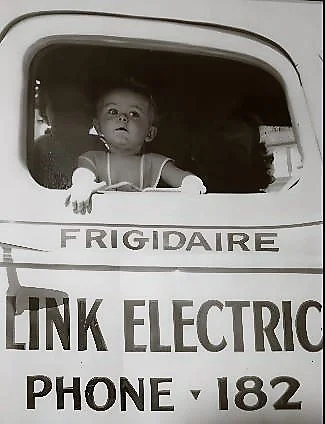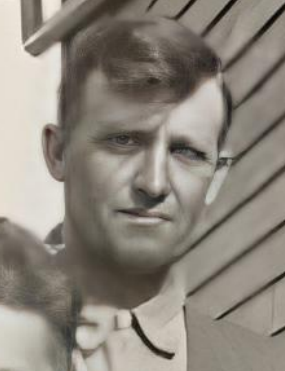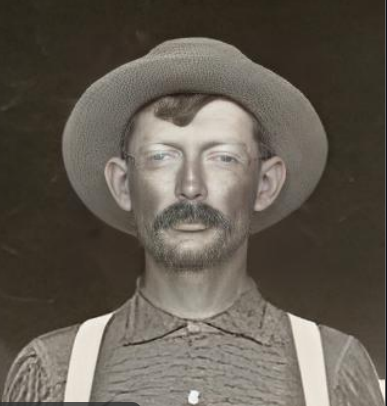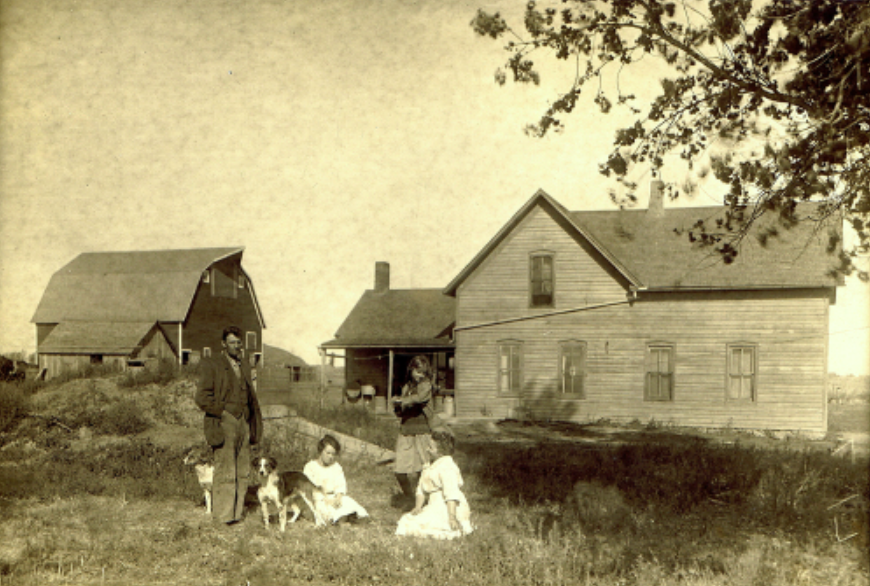OUT OF THE PITS
Forest E. Link, as the eldest of the children and nearing 22, was the first to leave Obar, NM, heading out on the Rock Island to the Northeast.
Forest Elmer Link in his barber shop very early in his career.
The family realized it would be necessary to get themselves out of Obar on somewhat of a piecemeal basis. The year of making this decision would have most likely been 1912. With Forest and Oscar (and eventually Elden) already working at “Gravel Pit,” a place name, and the family also running a boarding house for workers and visitors, money had been saved. And, almost certainly, the profit from the sale of a large farmhouse and outbuildings on acreage in South Dakota would have covered the expense of free homesteading with a modest home and buildings in New Mexico with savings left. The decision to leave, how to leave and when and where to go was probably a plan made by the family together over the dinner table in their small farm home. It must have been a difficult reckoning.
To receive the patent to the tract of the 160 acres of their homestead (similar to “clear title” today), the family would also have to continue to farm to prove up their claim. They had already invested in significant improvements with a large barn and small home. Fencing and field preparation were other improvements undoubtedly made to start farming. Although the land would be worth far less than had homesteading proved successful - and with a town which was already beginning to thin rather than grow - at least after proving up, they would be able to retain ownership until some sort of offer came through. It is unknown who bought the homestead, but a new ranch built from a number of the claims was the most likely form of transfer. This could have happened immediately, but without special incentive to rush in, the land may have languished for years before being sold to a rancher.
First up the Rock Island Railroad
Highway 54 follows the route of the Rock Island today.
It must have taken some fortitude to jump out on his own after being part of such an integrated family. Or, perhaps with his outgoing ways, Forest was excited to leave the dust of the northeast New Mexico plains behind.
Forest’s first stop up the Rock Island line to the east took him to Liberal, KS. That, according to Edna, was where the money ran out. In Liberal, Forest began learning the barber trade. As soon as he demonstrated he could be employed, Oscar, who was 18, soon followed with the next batch of saved funds. Both quickly learned the “tonsorial arts” with Oscar working next to his brother.
By January 29th, 1913, cards from Obar were reaching Forest in Pratt, KS. In Pratt, Forest had taken another barber position. From seating in a shop photograph (owners generally worked the most lucrative and prestigious "first chair"), it is known he first worked for the Royal Barber Shop (the name can be seen in shadow of one of the earliest shop pictures). Later he owned the business, giving it the family name - Link Barber Shop. Again, Oscar had followed his older brother.
In Pratt, Forest fell in love with Beatrice Wilson who was 18 and born in that county seat. “Bea” was the daughter of Olive and Joseph “Frank” Wilson who was later found - after following up family rumors at a reunion in Western Kansas - to be born Joseph Franklin Bradley in Gonzales, TX. Bradley had become a Texas Ranger at a young age. In one of his encounters, a horse trade that unraveled, Bradley ended up shooting two members of a large family in the county.
Then followed three days of hiding out in the woods near Gonzales and being fed by his wife who must have delivered the news to him that he would not be forgiven by the dead men’s families regardless of the circumstances or who might have been at fault. Bradley changed his name to Wilson, the name of the neighboring county where he registered the change and stopped only after he reached Pratt in Kansas. His days as a Texas Ranger were behind him.
Beatrice and Forest Link in 1915.
Olive May Wilson (Lang), and Frank Wilson, Bea Link’s mother and father. Restored and enhanced from period drawings.
Forest and Ned receiving Frigidair appliances in the 1940s for Link Electric.
Link Electric truck with Forest’s grandson, Forest Lee Link, 1939.
Charles Ulysses Link at the second South Dakota farm in 1915.
J. Frank Bradley, who was a Texas Ranger. He changed his name to Frank Wilson and moved to Kansas after a fire-fight over a horse trade that went awry in Gonzales County, Texas. Bradley (Wilson) was Beatrice’s father.
Wilson (Bradley) worked his way up in Pratt County until he ran a large harvesting equipment operation that migrated from south to north as harvest seasons arrived. Later, he also moved houses, something that was done in the early half of the 20th Century. When the county seat was finagled from Iuka, 6 miles north of Pratt, Wilson moved many houses to the new center of government. He married Olive May Lang, with relations to the Butterfield Stage family. Their only child was Beatrice. Frank Wilson lived into his 90s.
When Forest and Bea had their first - and only - child in 1915, they named him Ned Wilson Link. After the Bradley lineage was re-discovered, it was found that the name Ned may have been suggested by Wilson (Bradley). His little brother Ned died in his first year.
Business and city outpace farming and rural lifestyles in America
By the 1920 U.S. Census, for the first time in her history, America had more urban dwellers than rural.
The Links who returned to farming in South Dakota, where they had banking connections ready to help them start over again, included Charles and Clara, Edna and Mary. Elden had taken an opportunity to move near Chicago where he eventually became the fire chief of Elgin, IL. Forest and Oscar lived and worked in Pratt with Oscar eventually moving to Orange County, CA. He and son, Ray, established Link Insurance, which grew to become a large firm.
Once more, the changes taking place in the nation were reflected in the Link family. Four members remaining rural and three of the children finding new paths in cities.
In several more years, Forest sold the barber shop to buy out an electrical contracting firm in town. He was interested in selling appliances in a town where things were growing. During the second World War, Pratt became a major Army air base where B-29 bombers were flown from production in Wichita to be outfitted for their final uses in the war effort. Mostly women pilots working for manufacturing plants in Wichita would fly the B-29 bomber aircraft without instrumentation, using dead reckoning and “seat of your pants” takeoff and landing skills to take them to Pratt for completion at the Pratt Army Airfield.The air field was also used as a major training facility from 1942 to 1945 and had three 8,000-foot runways. The Japanese were never aware of the Pratt facility location.
By 1950, Pratt had 7,500 citizens. The 2021 census figures show a population of 6,573. During and following World War II, when bombers were being outfitted with instrumentation just outside Pratt, the population swelled to around 12,000.
Farmers becoming non-farming business operators
During the war years, Forest was bond chairman in the county and eventually became county clerk.
His son, Ned, was an ordinance inspector for the Army and lived in Independence, KS, and Tulsa, OK, where munitions plants were operated. One night, one of the lines Ned and other inspectors had been on in the morning awoke him with explosions. An entire building had gone up. Facilities were spaced such that other lines were at a safe distance for such events, which were seldom, but not unknown.
Upon returning to Pratt, Ned worked with Forest at one of two different locations for Link Electric. Ned had married Lois Browne, daughter of a banker at People’s Bank at Main and 3rd Street. Bea ran the company books, Ned supervised much of the electrical contracting in the still-growing town and Forest was ever more engaged in county and civic pursuits. Those handsprings he had done in front of class back at Longstreet School in Indiana were rehearsals for public activies he would enjoy throughout his 82 years. Forest was elected both State President of the Benovelent and Protective Order of Elks, as well as District Governor of the Kansas Lions Club.
The final return to South Dakota offered stability, and security
The family members who returned to South Dakota to farm - where no homesteading opportunities any longer existed - were content just to be back in an area where farming was possible, if often weather-challenged.
Correspondence from Edna Link (Jones) did not indicate whether peace was ever made between C.U. or Clara and the blizzards and tornadoes. They did, however, have a storm cellar on the new farm, a large farmhouse and a generous barn and side building. In 2020, South Dakota produced 777 million bushels of corn, more than any other state, in a country that grew more corn than any other producer in the world.
In reflection, even with the constant promise of the West beckoning over the decades, Charles looked back most fondly on his Indiana years. In 1937, a year before his death at 69, Charles Link wrote to his fellow Longstreet School scholars having a reunion back in Indiana:
Charles Ulysses Link, the family dogs, Clara Malinda Link (Berkey), Mary Link and Edna Link at the second South Dakota farm after coming back from New Mexico. Just behind the four remaining Links is the family’s storm shelter.
“You need to be congratulated for your good judgment in sticking to the Old Hoosier State. She is a reliable state. I never saw a total failure while living there.”

